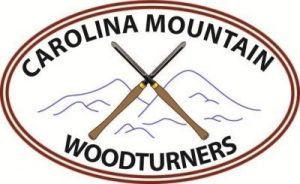John comes to us from Tennessee where he was introduced to woodturning during his job as a photographer for Tennessee Technical University. There he met John Jordan, went to his first AAW symposium as a photographer and got hooked on turning. He has put out several youtube videos explaining how to use various tools to produce the same results and in handling sharpening problems. You can access these at johnlucas60.com. John’s email for additional information is [email protected]
In today’s demonstration, John made Christmas ornaments to demonstrate various texturing and embellishing techniques. In addition, he demonstrated creating an inside out ornament.
Textured Christmas Ornaments:
Ornaments were turned from hard maple using a ½ inch roughing gouge – and high speed for a smoother cut. A light-colored wood works best for coloring, but other good woods are mahogany or pine. The ornaments are not hollowed out. A cove is placed near the top.
S
For texturing, John used a Sorby texturing tool which has 3 cutters: a star wheel, which can be used to create spiraling when used at an angle, or straight into the wood to produce a stippling effect. A ball cutter is used in the hollow of the cove, and on each side of the cove. A chatter tool, which can only be used on end grain. This tool must be held away from the wood – the farther the tool rest is removed from the wood, the more vibrations will occur. John discussed other types of texturing ideas – he suggested making a texturing board to explore various options. Patterns can be make using a wire brush, using Dremel tools, carvers, engravers using a scribbling movement to produce a leather appearance, wood burning and leather texturing tools.
Much of the texturing will become more visible if the wood is colored. John used Tombow markers – these have both a fine and bolder end – that can be obtained at an art supply store. In addition, a sharpie marker can be used. Grooves can be cut between the colors and darkened with water-based calligraphy ink. In addition, a smaller roller brush can be used to color only the high points of the texture. John has also used thick colored wax to fill in groves of the texture – especially good with chatter tool marks. Metallic luster wax (purchased at Hobby Lobby) or liming wax can also be used.
Finishes will change the color of the markers – especially Sharpie markers. Thus, the sequence of finishing his ornaments is first to do the texturing, second, to finish the wood and then color the wood. For finishes, John uses Parafix 3405 which is a medical grade CA with low fumes. He has also used Min-wax wipe-on Poly, and sand sealer.
To hang an ornament, John uses wires for ear rings, cuts them down and glues them into a small hole on top of the ornament. In addition, John demonstrated adding a chain attached to a small charm at the bottom. To insert the chain, John coated the end of the chain with medium CA glue which stiffened the end of the chain. A small hole was then drilled at the bottom of the ornament to fit the chain.
Inside-Out Turning
For inside-out turning, 4 pieces of wood are glued together and treated as one piece. The pattern which you want on the inside in John’s example, a heart, is turned on the outside of the piece. Once this pattern is turned, the pieces are separated and reglued so that the turned portion is now on the inside. The new outside is shaped as desired.
Forming the first turning: You can either take 4 pieces of wood sand the edges well and glue them together so that you have a smooth fit. An easier option is to take a larger piece of wood and using a band saw, cut this piece into 4 separate pieces. The advantage of this is that the pieces should fit together snuggly and that any grain pattern will match. The joints can either be glued with 2 dabs of CA on the ends of each of the 4 pieces or by forming a paper joint (glue both sides of the paper between 2 pieces of wood). The paper joints may be more secure for larger pieces. Draw arrows indicating the inside and outside of each piece and nick the corners toward the inside joint. This is helpful is reassembling the 4 pieces for the second turning in the correct orientation.
The first turning:
John used a pattern drawn on paper for his heart shape. He turned his first piece into a cylinder and shaped half of the heart into the cylinder. Don’t use a cone center since it might separate the pieces. Make sure you have enough wood left in the center to allow you to shape the outside later. Sand the shape – before reassembling it.
Separate the glue joints and reglue in the correct position – making sure that the glue doesn’t get into the inside area. Sand the joint if necessary to make sure its smooth. Remount the piece between centers and turn a tenon. Shape the outside as desired, being careful as you get near the top part of the heart since the wood is thinner at this point. Sand and drill a 3/8 inch hole for a finial.
John also showed us how he used this technique to create a platter with double ring pattern. One set of rings that were turned first, then the second after the pieces had been re-assembled












